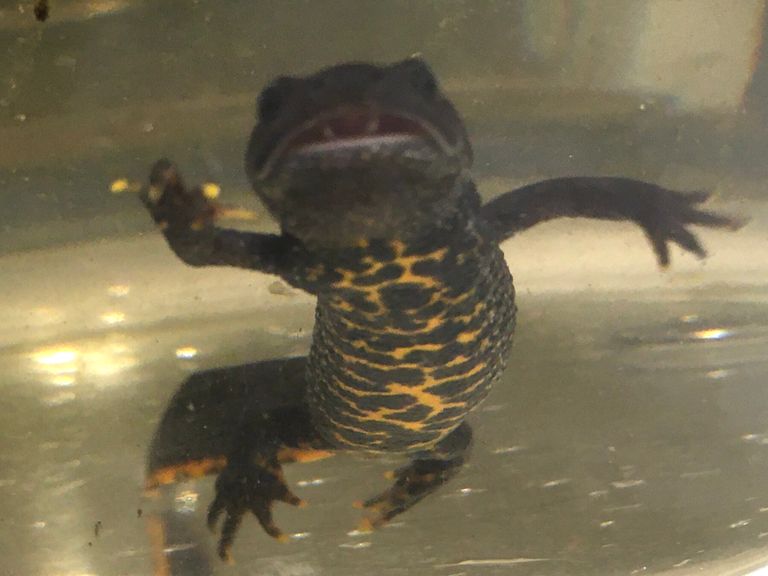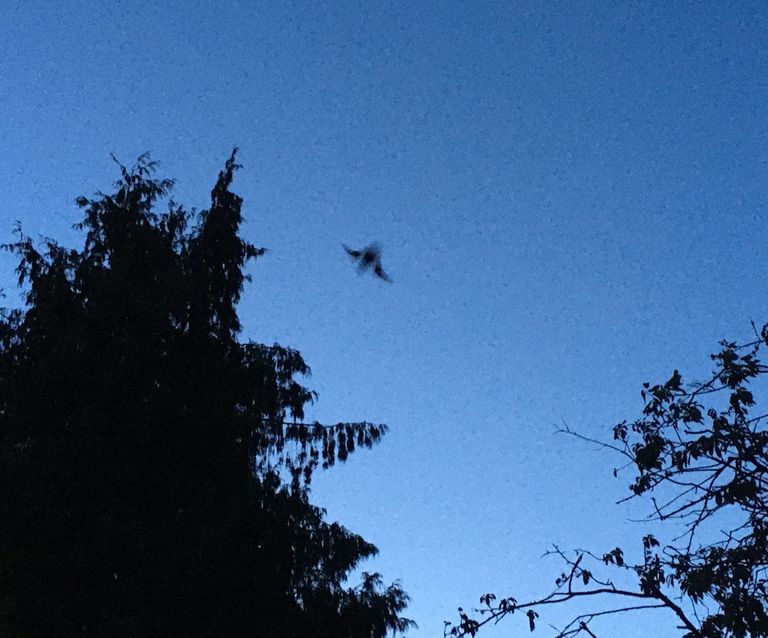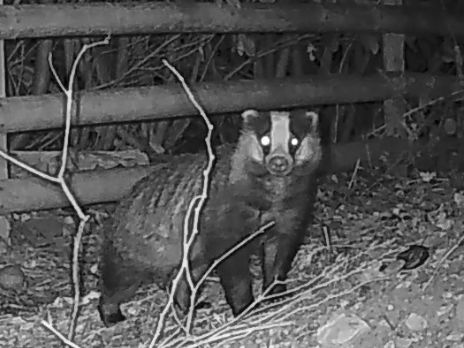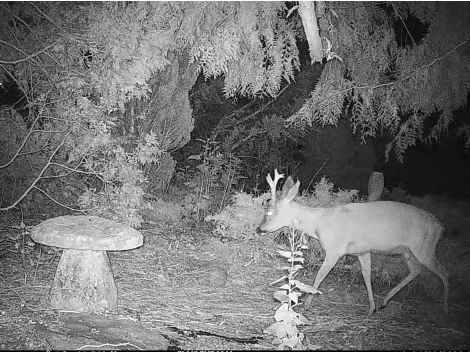
WILDLIFE AND ECOLOGY
The application repeatedly claims that wildlife and ecology will not be affected.
This is simply not true.
This photo shows how close the courts are to open countryside. The community living around the courts reports seeing a wide variety of wildlife including bats, badgers, owls, hedgehogs, deer, foxes and a huge variety of birdlife. A wildlife pond in a garden only 11 metres from the courts supports a wide variety of aquatic life and amphibians including great crested newts.
Artificial light significantly disrupts natural patterns of light and dark, disturbing invertebrate feeding, breeding and movement, which can reduce and fragment populations. Some invertebrates, such as moths, are attracted to artificial lights at night. It's estimated that as many as a third of flying insects that are attracted to external lights will die as a result of their encounter. Insects can become disoriented and exhausted, making them more susceptible to predation. Many invertebrates natural rhythms depend upon day-night and seasonal and lunar changes which can be adversely affected by artificial lighting levels.
A number of our British mammals are nocturnal and have adapted their lifestyle so that they are active in the dark in order to avoid predators. Artificial illumination of the areas in which these mammals are active and foraging is likely to be disturbing to their normal activities and their foraging areas could be lost in this way.
WODC's Biodiversity Officer recommended the 2019 application for refusal saying: I therefore conclude that the information submitted with the application is insufficient and that the proposed floodlighting at this location is likely to result in biodiversity harm, which is contrary to Policy EH3 of the Local Plan and the relevant legislation protecting bats and great crested newts, including The Conservation of Habitats and Species Regulations 2017.
In 2021, WODC's Biodiversity Officer refused the application saying: It is considered that insufficient ecological survey information, assessment or mitigation information has been submitted to enable the Local Planning Authority to fully assess the extent to which species and habitats (including bats and great crested newts) that are protected under the Wildlife and Countryside Act 1981 (as amended), The Conservation of Habitats and Species Regulations 2017 or listed as species/habitats of Principal Importance in s.41 of the Natural Environment and Rural Communities Act 2006 may be affected by the proposed development.
WTC have done no ecological surveys or proper assessment particularly for bats and great crested newts and mitigation measures are insufficient.
The West Oxfordshire Local Plan 2031 contains policies to protect local wildlife and the environment:
Policy EH1 states that ‘In determining development proposals within the Cotswolds Area of Outstanding Natural Beauty (AONB) and proposals which would affect its setting, great weight will be given to conserving and enhancing the area’s natural beauty, landscape and countryside, including its wildlife and heritage. This will include consideration of any harm to the contribution that the settlement makes to the scenic beauty of the AONB.
Policy EH3 states that the biodiversity of West Oxfordshire shall be protected and enhanced to achieve an overall net gain in biodiversity and minimise impacts on geodiversity.
Policy EH4 states that lighting will not adversely impact on green infrastructure that functions as nocturnal wildlife movement and foraging corridors.
Policy EH8 states that external lighting should not have a detrimental effect on intrinsically dark landscapes and nature conservation.

Great Crested Newts
Triturus cristatus
Great crested newts were present during the breeding season this spring/summer in the pond at Elmdene, just 11 metres from the tennis courts. This has been reported to TVERC (Thames Valley Environmental Records Centre) and verified.
The great crested newt is the largest of the European newts at up to 17cm long. They are nocturnal and can live up to 15 years. Newts are amphibians, breeding in ponds during the spring and spending most of the rest of the year feeding on invertebrates in woodland and hedgerows. They hibernate underground, among tree roots and in old walls.
Newts perform important functions which inadvertently benefit humankind by contributing to “ecosystem services”. One service is the cycling of nutrients from water to land and back again, thanks to their complex lifecycles. This contributes to soil fertility, a service our overworked soils desperately need if we are to provide enough food for a growing population.
Over the years, great crested newt numbers have been declining and they are protected by law, officially classed as an endangered species.
The major reason for decline is habitat destruction through urban and agricultural development, affecting the aquatic breeding sites as well as the land habitats. Their limited dispersal makes the newts especially vulnerable to fragmentation, i.e. the loss of connections for exchange between suitable habitats.
There is no survey for great crested newts in this application.
Bats
Chiroptera
Nearly all neighbouring residents report enjoying watching bats in the evenings from February/March to October/November. Bats have been seen emerging from the eaves in a neighbouring property and a whole colony were seen flying down Church Path towards the tennis courts. Bats are seen virtually every night over the pond at Elmdene (photographed here) and flying along the hedgerow bordering the tennis courts. This has been reported to TVERC.
Bats play an important role in the environment but are sadly in decline in the UK. Intermittent bright lighting such as floodlights will affect foraging and may cause bats to abandon their roosts affecting the survival of a colony. Guidance states that bats are less disturbed by light in the 'warm' spectrum (ie less than 2700 Kelvin).
In 2019 the WODC Biodiversity Officer identified the hedge on the western boundary of the courts with the property Elmdene as 'a key commuting corridor and/or foraging habitat'. In her expert opinion it was highly likely that bats would be roosting in the roofs of most surrounding buildings including the New Beaconsfield Hall, especially the western side as they prefer the warm. She said: 'without an updated bat activity survey it is difficult to predict what the impact will be on these species'.
There is no bat activity survey in this application.


Badgers
Meles meles
Badgers are frequently seen very close to the courts in the garden of Elmdene as photographed here. Wildlife video footage shows them coming in from the field bordering the courts on the NW side and exiting the back of garden towards the tennis courts. There is even a rare erythristic badger. These sightings have been reported to TVERC.
There has been a badger latrine on the border of Elmdene's garden and the adjacent field, just 15m from the courts, with a clearly visible pathway through the hedge, meaning a sett is probably close by. There are also often 'snuffle holes' in the lawn at Elmdene where the badgers search for earthworms - they can eat up to 200 a night.
Badgers are nocturnal animals so these very high levels of artificial light could be hugely disruptive to their normal activities.
Hedgehogs
Erinaceus europaeus
Hedgehogs have been seen in gardens on 3 sides of the tennis courts including this one photographed in the garden at Elmdene, in the hedgerow adjoining the tennis courts. This has been reported to TVERC.
Hedgehogs are in decline in Britain and are now listed as "Vulnerable" on Britain's red list of mammals. According to the latest State of Britain's hedgehogs report, numbers of hedgehogs have fallen by up to 30% in urban areas and 50% in rural areas since the Millennium.
Hedgehogs are nocturnal so these high levels of artificial light could be hugely disruptive to their normal activities.


Foxes
Vulpes vulpes
Foxes are regularly seen on camera in the garden at Elmdene, using the wildlife corridor connecting the adjacent field with the land around the tennis courts and the countryside beyond. These sightings have been reported to TVERC.
Rural foxes are mostly nocturnal. Sadly this one had what appears to be a strap, possibly a home-made snare, around its middle.
Owls
Tyto alba, Strix aluco
Many neighbours report seeing and hearing both barn owls and tawny owls at night. One resident of Meadow Lane reports seeing a barn owl flying up and down the field towards the courts at night to hunt. Another resident in Meadow Close recently reported a barn owl in his garden being chased off by a very territorial blackbird!
Being mainly nocturnal, owls would be significantly affected by the floodlights, cutting down their potential hunting/feeding time.


Deer
Capreolus capreolus, Muntiacus reevesi
Both roe deer (photographed here) and muntjac cross the back corner of the garden at Elmdene connecting the field and the land adjoining the tennis courts. Many neighbours report seeing muntjac in their gardens and they are caught on the Elmdene wildlife camera almost every night. These sightings have been reported to TVERC.

Amphibians, reptiles and pondlife
This wildlife pond is just 11 metres from the court fence. It supports a huge variety of wildlife including newts (great crested, smooth and palmate), frogs, toads and grass snakes which use the nearby compost heaps for laying their eggs. Amphibians are hugely affected by artificial light which disrupts their nocturnal activity, interfering with reproduction and reducing populations. The pond also supports dragonflies, damselflies and other forms of pondlife, all of which will be impacted by artificial light.
Contact us via email: mailto:info@shipton-under-floodlight.co.uk
© Copyright. All rights reserved.

